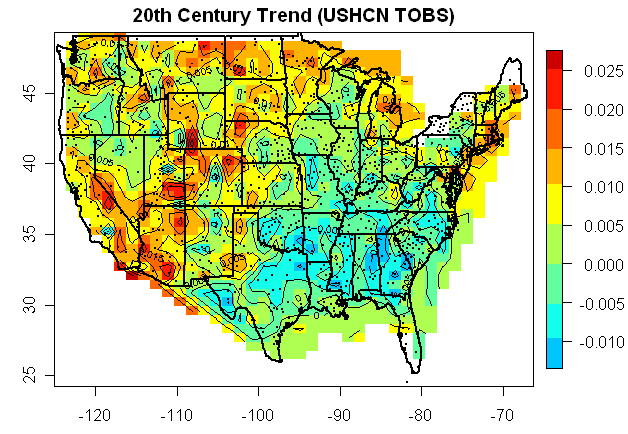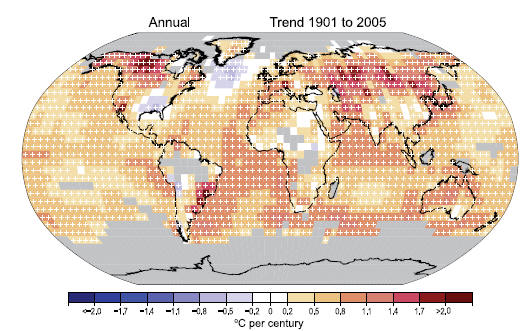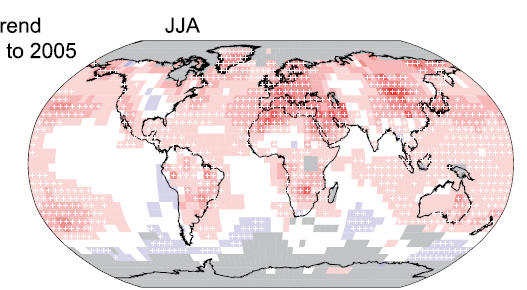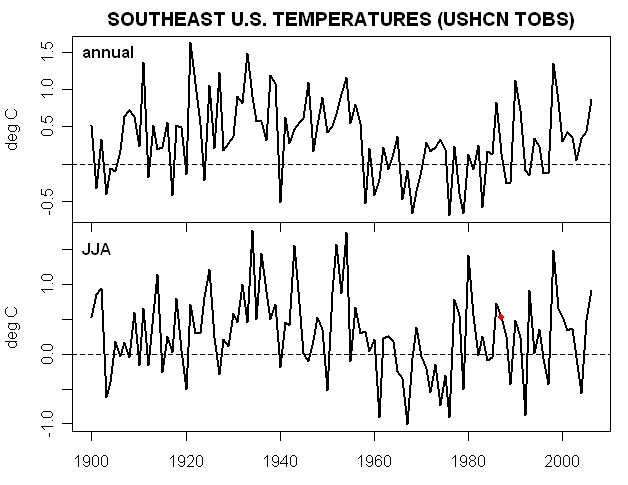Hansen et al 1988 reported that they expected extra warming in the SE United States, a theme that was mentioned in his testimony in Washington in summer 1987. Hansen et al 1988 stated:
there is a tendency in the model for greater than average warming in the southeastern and central U.S. and relatively cooler or less than average warming in the western U.S. and much of Europe in the late 1980s and in the 1990s. …
We also notice a tendency for certain patterns in the warming, for example, greater than average warming in the eastern United States and less warming in the western United States. Examination of the changes in sea level pressure and atmospheric winds suggests that this pattern in the model may be related to the ocean’s response time; the Atlantic off the Eastern U.S. and in the Pacific off California tends to increase sea level pressure in those ocean regions and this in turn tends to cause more southerly winds in the eastern U.S. and more northerly winds in the western U.S. …
Monthly temperature anomalies can be readily noticed by the average person or ‘man in the street’. A calibration of the magnitude of mode predicted warming can be obtained by comparison of Plate 6 with maps of observations for recent years as published by Hansen et al 1987 using the same color scale as employed here. This comparison shows that the warm events predicted to occur by the 2010s and 2020s are much more severe than those of recent experience such as the July 1986 heat wave in the southern U.S., judging by the area and magnitude of the hot regions.
Here is a an excerpt from Hansen et al Plate 2 illustrating the model output which supported this observation. Scenario B is the one that corresponds more closely to actual forcing. I’ve shown Scenario as well, on the basis that Scenario B is only shown here for the 1990s and arguably Scenario A in the 1990s yields insight into Scenario B in the 2000s. The salient point of the diagram here is the structure of the “dipole” clearly visible in A in which there is cooling in the western US and warming in the eastern US. In Scenario B, the dipole is less evident, but is perhaps directionally there as well.
Image may be NSFW.
Clik here to view.
There are many interesting aspects to this. Remember Michael Mann’s claim in regard to bristlecone pines – that the southwestern U.S. is a “sweet spot” for measuring climate change. In Hansen’s model, the southwest U.S. has very anomalous behavior. For some reason, in Scenario A in the 1990s, it is one of only a couple of regions in the entire world where Hansen’s model predicted cooling. Seems like an odd sort of “sweet spot” for measuring global temperature.
Now here are several plots showing observed trends. First here is a plot that I did earlier based on USHCN TOBS data (annual here rather than summer – I’ll try to do summer as well some time, but this is what I have on hand). Again one sees sort of a “dipole” structure between the eastern and western US that resembles the dipole structure in the Hansen et al 1988 model with one small problem – the sign of the change is reversed.
Image may be NSFW.
Clik here to view.
For someone that’s worried about whether my calculations of 20th century trends are accurate, here is a figure from AR4 also showing a cooling trend in the southeast and a warming trend in the west.
Image may be NSFW.
Clik here to view.
Actually AR4 even has a map that supports the point for JJA temperatures from 1979-2005, as shown in the graphic below:
Image may be NSFW.
Clik here to view.
I also did a quick calculation making an annual and JJA average for all USHCN stations (TOBS) that were located east of 100W and south of 37N as a rough approximation to the southeast. Here’s the result that I got. Based on this calculation, the number of warm summers in the period 1987-2007 is greater than the period 1951-80 (“climatology” in Hansen et al 1988) but not greater than the period 1920-1940 for example.
Image may be NSFW.
Clik here to view.
Average calculated for USHCN stations east of 100W; south of 37N ; red is 1987
Again I’m not saying that any of these details disprove GHG forcing. However Hansen specifically discussed the southeast US both in his article and emphasized it in his testimony and the actual results should be at least canvassed briefly before saying that Hansen is the new Nostradamus.
It’s also interesting to contrast the presentation of this topic in Hansen et al 1988 with Hansen’s 1988 testimony here. The description of warming in the eastern U.S. in the testimony tracked the corresponding text in the original article quite closely as you can see in the excerpt below:
in the late 1980s and in the 1990s, we notice a clear tendency in the model for greater than average warming in the southeast U.S. and the midwest….In our model this result seems to arise because the Atlantic Ocean off the coast of the U.S. warms more slowly than the land. This leads to high pressure along the east coast and circulation of warm air north into the midwest or the southeast. There is only a tendency for this phenomenon. It is certainly not going to happen every year and climate models are certainly an imperfect tool at this time. However we conclude that the greenhouse effect increases the likelihood of heat wave drought situations in the southeast and midwest U.S. even though we cannot blame a specific drought on the greenhouse effect.
But there is one noticeable difference between his 1988 testimony about what the model predicted for the United States and what was mentioned in the corresponding text in Hansen et al 1988. See if you can find it.
Image may be NSFW.
Clik here to view.
Clik here to view.
Clik here to view.
Clik here to view.